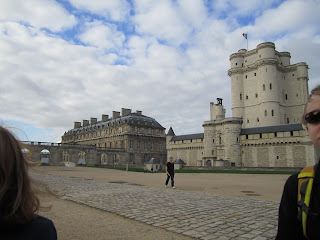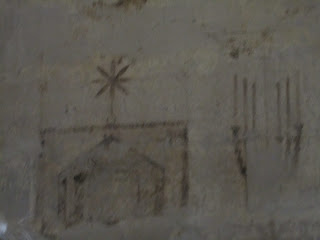But anyway, let's get to the point of this blog post. Here I will be recounting the events of last weekend, where I traveled with the Tufts University group by train and bus to various locations in Normandie and Bretagne (in English known as Normandy and Brittany), two regions located in western France, bordering the Atlantic Ocean/English Channel.
Well, I awoke at 4:45 am on Saturday, after a night of baking a batch of oatmeal chocolate chip cookies that turned out more or less successful considering I forgot the baking soda, couldn't find chocolate chips (I cut up bars of chocolate), and added too much butter. But hey, life's is all about the process of learning. We took the 7:45 am train from Paris to Caen, and from there a bus from Caen to the Musée du Débarquement (Museum of the D-Day Landings), in the town of Arromanches-les-Bains, nicknamed Gold Beach and used by British troops during the invasion. In honor of this, there are British flags flying all over the town. The visit to the museum was quite interesting, as they had relics on display from all the countries (I think) that participated in the Allied war effort, and had a number of interactive exhibits. They do tours in English too. Btu the really cool part is the beach (obviously), and those big gray lumps you see in the water in the photo above and some below. These are the remnants of the artificial port built by the Allies for the invasion (Churchill's brainchild), which was a huge effort involving two years, 30,000 workers, smoke machines, and purposefully sinking the docks multiple times before the actual invasion. Most of the docks have sunk by now, and sadly the few remaining are rusting and not taken good care of, but you still get the overwhelming sense of the enormity of the effort.
Here's a nice view of the beach and most of the town, which was obviously mostly destroyed by the Germans, who occupied it during the invasion, and during the invasion itself. That's pretty much the story of half the towns in France, though.
Here's me sitting on a wall above the beach. Note: that is absolutely not real fur. And if it is, I got a sweet deal on it because it cost me less than a street crepe.
A view of one of the "back-up" docks, which is less rusted than most.
More gorgeous beach. And yes, the weather is always like that there. It's appropriate for the region though. In fact, I think I preferred it to sunny weather.
A close up of the rusted out dock. By the way, the whole thing floated. It was all temporary.
After the museum, we made our way by bus to the American Cemetery at Colleville, aka Omaha Beach. The cemetery is actually American soil (so I took the liberty of speaking English), and overlooks the landing beaches. Nearly 10,000 men and 4 women are buried here, all of whom except one died during the D-Day campaign. This exception is one of the sons of Theodore Roosevelt, who died during WWI, and who was moved to be laid to rest next to his brother. Also buried at this cemetery are the brothers on whose story the move "Saving Private Ryan" is based. On the crosses/Stars of David the names (if known), Army details, state of origin and death date are written. No birth dates are given because many men lied about their age to get into the army. In addition, there's no order given to the placement of the gravestones, to symbolize the fact that these men and women all died as one unit, the Generals along side the Privates, and that they all deserve the same respect and honor.
And here is the magical, mystical, Mont Saint-Michel, a monastery dating back to the 8th century as well as a former stronghold and a prison. In my opinion, it also looks like a city straight out of Lord of the Rings, which is why I love it. The Mont is a point of contention between Bretagne and Normandie, though, as each claim it belongs to their region. Gosh, where have I heard that argument before? Anyway, within the past decade, they have reinstated an order of Benedictine monks and nuns, who live and work here. The entire population of the tidal island is around 44 people, though a lot more work there during the day. The reason the monks decided to build a monastery here, on a pile of rocks sitting on some silt only meters away from the ocean, is apparently because the Archangel Michael came to St. Aubert in a dream in 708 and told him to do it. Apparently St. Aubert refuse the first time, and the angel burned a hole in his skull. Well, I guess I'd give it a go too if someone did that to me.
Here's an example of the narrow, steep, twisty-turny streets that wind up to the monastery and church.
A view of the tidal bay from about halfway up. It's amazingly isolated and desolate feeling, but also stunningly beautiful. Probably made a good atmosphere for the monks back in the day. And now, I suppose.
Here's the outside of the abbey.
And the inside.
The cloister of the abbey, part of the "Merveille," a Gothic section also including the refectory and two other buildings constructed in the 13th century with funds from King Philip Augustus of France. Another fun fact, for nearly 1,000 years Mont Saint-Michel has been used as a site for pilgrims hoping to receive eternal life from the Archangel. They slept in the basement of the abbey, though royal pilgrims such as the King had a separate, fancier hall which is also still standing.
This is the giant wheel used to hoist supplies and such up from the base of the mount.
Me taking a break from climbing up a bajillion stairs.
So here's my dinner from that night. My appetizer was a "Charlotte" of smoked salmon with an herb sauce. I think the "Charlotte" part refers to the cream cheese-y bit underneath the salmon.
My entree was a lamb kebab with bulgar and vegetables. By the way, if you ever get a chance to get to this part of the world, make sure you try the lamb pré-salé (pre-salted). These are the sheep that feed in the silty tidal bay near Mont Saint-Michel, and since the vegetation there is fed by salt water, the meat of the lamb gets an extra delicious taste.
And my dessert was profiteroles (cream puffs), filled with Speculoos-flavored ice cream and doused in warm chocolate syrup. Speculoos is a Belgian biscuit and sandwich spread that has a salty gingerbread sort of taste.
On Sunday we spent the day in Saint-Malo, a walled port city dating back to the Middle Ages located in Bretagne (Brittany), on the French side of the English Channel. The city includes numerous islands, such as the one pictured above, that served military purposes in pretty much every war until the end of WWII.
Here's a view from on top of the ramparts surrounding the city, which as you can see is right up on the edge of the water. The wooden posts on the beach have something to do with protecting the walls/preventing erosion. This picture was taken during high tide, but when it's low tide you can walk out onto the islands.
A view into the city from on top the ramparts. As 90% of the original city was destroyed during WWII, pretty much everything you see here was built post-war, though the city made a smart move in deciding to rebuild the city exactly as it was before, right down to the original building materials. You can't even really tell that anything happened.
Another view from the ramparts. Though it was probably just about 50 degrees or less that day, there were still several people out swimming, and lots of sailboats. During the summer months, this place is crazy with tourists.
Me on the beach, waiting for low tide so I can head out to the island.
The crepe restaurant where we had lunch. A "lutin" is a sort of dwarf/elf/sprite/brownie, generally mean-spirited. At all the restaurants here your meal comes with "cidre" (alcoholic cider), as this is the apple-growing region of France.
Me hanging out on the rocks, hunting for seashells and sea glass, of which there are plenty.
A view from the beach of the wall surrounding the city.
More beach views.
On one of the islands, after the tide finally went out. This here is the grave of François-René de Chateaubriand, a French writer and founder of Romanticism born in Saint Malo, who died in 1848 and asked to be buried here.
Also on the island, this is where German cannons once stood during World War II, as the Germans occupied Saint Malo. They were used to defend against Allied air forces. Which technically means that Saint Malo was destroyed by Allied forces during the war, not the Germans. Awkward.
Another specialty of the region, a little cake made of a ton of salted butter, and in some cases also with caramel. It is heaven. I recommend it to everyone. Not pictured here is the pastry I ate immediately after this, which was basically fresh apple rings covered in batter, fried, and sprinkled with chocolate chips. You really can't go wrong with that.



























































